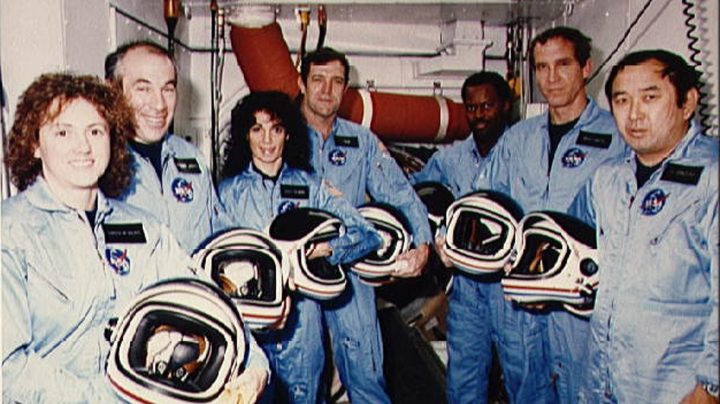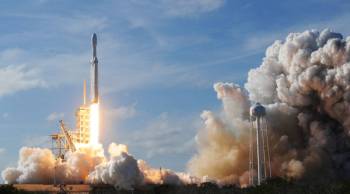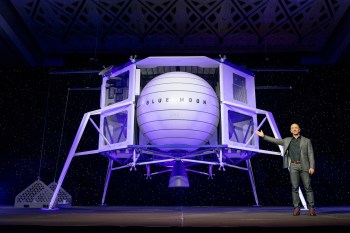
How the “new guys” of NASA’s Group 8 opened up space travel to the rest of us
How the “new guys” of NASA’s Group 8 opened up space travel to the rest of us

NASA today has ceded quite a bit of its low-orbit space travel to companies like Blue Origin and SpaceX. But the only reason these companies can operate the way that they do, where anyone with the financial or social capital can be an astronaut, is because NASA lifted barriers on who could even enter space in the first place.
NASA didn’t always operate that way. There was a time when astronauts were solely recruited from a pool of white, male military pilots. It wasn’t until 1978 that NASA’s Group 8, a class of 35 new astronauts with a mix of backgrounds, genders and ethnicities, opened the door for a whole new generation of spacefarers.
Meredith Bagby is author of the book, “The New Guys: The Historic Class of Astronauts That Broke Barriers and Changed the Face of Space Travel.” She joined Marketplace’s Kai Ryssdal to talk about the new book and the impact that this group of astronauts had. A transcript of their conversation is below and has been edited for clarity.
Kai Ryssdal: I want to go to the subtitle first. So the book is obviously called, “The New Guys.” And then the subtitle is, “The Historic Class of Astronauts That Broke Barriers and Changed the Face of Space Travel.” I want you to remind everybody what the face of space travel was before NASA’s Class 8, would you?
Meredith Bagby: Sure, sure. So prior to 1978, most or all astronauts were white, male military pilots, and most of them were test pilots. And that had been the case since the beginning of the space program.
Ryssdal: Was it then a deliberate choice? Was it forced upon the higher-ups at NASA? How did it come to be that they woke up one day in 1976 when they started the selection process for this class and said, “Oh, no, we need people of color and women too.”
Bagby: It was a long process. But of course, in 1964, the Civil Rights Act passed, and through the late ’60s and the ’70s increasingly, there was pressure on NASA to open its doors to women and people of color, as it was the law to include them. And then finally, in ’78, they did. And part of the reason they did was that they had this brand new space vehicle — the space shuttle — that could carry more than just pilots. And so finally, they did have room, even though women and people of color had already qualified as pilots. But this was a greater opportunity to bring more kinds of people on board.
Ryssdal: So as we get to the space shuttle and this class, the new guys — who were not all guys, obviously — what is NASA thinking about its relevance and its future? Because Gemini and Apollo and Mercury had been amazing and all of that, and now they have this new thing: They’ve got to figure out the space shuttle. But it’s also a time when budgets are tight because of Vietnam. And, you know, it’s the 1970s. Things were not great in this country in the ’70s.
Bagby: There was a much bigger plan for NASA after Apollo. They wanted to build a space station, and they wanted to build lunar landing stations, and they wanted to bring a fleet of shuttles into being. And because of the budget battles and the rotten economy, the only thing that squeaked by was the shuttle. And, you know, they eventually were able to get three of them. And eventually, the fleet expanded. But if NASA didn’t get the shuttle, NASA’s future was really threatened. And the fact that they were able to sneak the shuttle through was a big deal. But of course, the shuttle, as a result, always struggled. It had a budget that was far too small for its very lofty ambitions. And this was baked into the program throughout. And because of that, they had to put a lot of their technical issues on hold or push them forward. And of course, that came to bear when the shuttle started flying. They had a lot more technical difficulties than I think anybody imagined they would and ultimately got through a lot of them, but also had their first tragedy in the Challenger accident in ’86.
Ryssdal: Which, we should say, claimed the lives of four members of this class.
Bagby: That’s right. Yeah, this class was heavily impacted by that. Judy Resnik, who was the first Jewish woman to fly; Ron McNair, who was the second African American to fly; and Ellison Onizuka, who was the first Asian American to fly, all passed away on that flight.
Ryssdal: OK, so look, this, you know, it’s funny. I was flipping through the Wikipedia entry for NASA’s Class 8, and two things struck me. No. 1: OK, this is gonna sound terrible, but how old some of these people are now because they were born like in the early 1940s, right? I mean, this was a long time ago that these people joined the astronaut program. But No. 2: What do you think their legacy is, in terms of the NASA of today? Because NASA of today is, yes, thinking about going back to the moon, but also arguably a good deal less relevant than spaceflight than it used to be. Hello, SpaceX. Right?
Bagby: You know, NASA has turned over low Earth orbit to the commercial enterprises. But I think that the legacy of these astronauts was that they really created the face of modern space travel and the idea there is that everybody can get to come along — it’s not just military guys — and also how important scientists are. I mean, almost half of this group were scientists. But I mean, more globally, it’s this idea that everybody can come along and everybody should come along, and broadening the idea of what it means to be an astronaut.
There’s a lot happening in the world. Through it all, Marketplace is here for you.
You rely on Marketplace to break down the world’s events and tell you how it affects you in a fact-based, approachable way. We rely on your financial support to keep making that possible.
Your donation today powers the independent journalism that you rely on. For just $5/month, you can help sustain Marketplace so we can keep reporting on the things that matter to you.

















